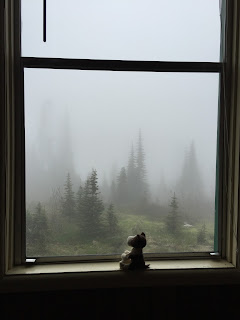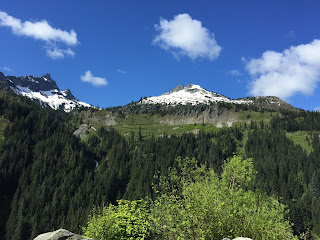Jeannette loves to cook and bake. A lot.
For the last two or three years she has dreamed of going to the King Arthur Baking Education Center to take baking classes. In case you don't know, King Arthur is a flour company. They make all kinds of baking ingredients and tools for home bakers. Their recipes are excellent and their website is very helpful to new bakers. So who better than King Arthur to teach Jeannette about baking?
The baking school is in Norwich, Vermont.
Which means this little dream of Jeannette's requires a plane trip, a rental car, and a multiple nights' stay in a hotel. Not cheap! Earlier this year her department won an award for their work and it included a cash prize. She decided to reward herself by putting the money toward a trip to King Arthur.
Uncle Mike came along for the trip to see New England for the first time. He does not bake.
Day 1: Ciabatta
Ciabatta (chi-ba-ta) is an Italian bread that is airy in the center with a crispy crust. The word "ciabatta" roughly translates into "slipper" because that's what the finished bread looks like: a slipper.
Here's Brownie sitting near the standing mixer, waiting for the class to start.
On the left side of this picture you'll see the corner of a scale. Baking delicious bread is a lot like a scientist mixing a formula. You need precise measurements to make sure the water, flour, yeast ratios are correct. One way to do that is to weigh your flour, and that's what we did in class.
Ciabatta is known as a "pre-ferment." That means the recipe requires a bit of dough that has already started to ferment before you begin baking (which is why we call it a "starter"). Why is a starter required? Flavor. Ciabatta has a unique flavor that can only come from a pre-fermented starter. We'll talk about fermentation and starters again further into the post.
After our instructor gave us the starter we added additional flour, water, yeast, and salt. We mixed our dough in the standing mixture to develop the gluten and moved it to a bowl to let it rise.
What is gluten? It's as essential to bread making as yeast. Gluten is a combination of two proteins (gliadin and glutenin) that gives bread its structure. If you don't knead the dough it will not develop enough gluten. Since this is a wet dough, it's easier to knead it using a standing mixer.
What is yeast? Yeast is a bacteria that eats sugar (like the sugars found in wheat flour) and burps and farts carbon dioxide. The carbon dioxide, along with the structure provided by the gluten, allows breads to rise. This is what makes yeast bread different from biscuits or pancakes when comparing taste and texture.
Bread usually requires two separate rises: the first to give it lift so you can shape the dough, and the second rise occurs after you shape it. Here we're letting it rest for the first rise.
Next we shaped the dough into long flat loaves. Here is our shaped ciabatta loaves all rested after the second rise.
We had enough dough to make little ciabatta rolls. They don't look tasty now, but they will after coming out of the oven.
The second dough (the one that included olive oil) was used to make focaccia (fo-cah-chia) bread. We put more olive oil in a baking pan, added the dough, pressed our fingers into the dough, and topped with salt, pepper, and fresh rosemary. You press your fingers into the dough to give it little dimples that soak up the oil. Focaccia is meant to be a bread that sustains you for longer periods of time, which is why extra fat is added to the dough.
Jeannette ate the finished focaccia bread for a snack over the next couple days. It was delicious.
Here are the loaves after they came out of the oven. Notice the dusty flour texture? It's easy to see where the "slipper" name came from. I assure you, they didn't taste like an old slipper.
Day one is done. Here's a picture of all the goodies Jeannette brought back to Mike.
Day 2: Basics of Bread
The second day was focused on learning the basics of bread making. This class was focused on learning how to knead by hand, how to shape dough, and how to properly mix non-yeast doughs.
Here is Brownie in the giant picture of a bag of King Arthur Flour. Can you see him poking out of the cutout?
Jeannette is getting ready for another class. She and Brownie drank a ginger ale before the class started. It was very spicy and delicious.
Here is Brownie sitting next to a loaf pan filled with shaped dough. This loaf will be used for sandwich bread. If you remember, a shaped dough has already had its first rise, which means it needs to have a second rise before baking.
One big lesson Jeannette learned is that she's been mixing flour into the dough all wrong. Start by mixing most of the flour in, but as you add the remaining flour don't mix it into the center of the dough, just add it to the outside and fold it in. The water in the center of the dough ball will slowly pull more flour in. Otherwise you'll add too much flour and your bread won't be as light and tender.
Day two ends with another big bag of treats. In the top left you see the sandwich loaf, on the right is a braided loaf made with the same basic dough. In the bottom left is a Sicilian bread made with a little semolina flour (the same type of wheat used in pasta). And in the bottom center are buttermilk & currant scones. We ate the scones for breakfast for the remainder of the trip.
Day 3: Sourdough
But first, a detour...
Each of Jeannette's classes started at 1pm so she had some time to kill before going to class. On the third day Jeannette and Mike went to a local children's museum for fun. Here's Uncle Mike in the bubble exhibit. If you look closely you can see that he is surrounded by a bubble.
But what about the Sourdough class?
Sourdough is a special kind of dough. It doesn't rely on store-bought yeast to give it its taste and lift. Instead, it uses a wild yeast starter. Check out this video by Alton Brown to learn more about how wild yeast starters are used in bread making.
Here are the finished loaves from day three. See the little white jar by Brownie? That's a starter the instructor gave us to continue making delicious sourdough bread at home. I have to feed the starter flour and water to continue to keep it alive.
Sourdough is called that because the wild yeast gives it a sour flavor. It's the kind of flavor you taste in sour cream or sour pickles. It's delicious on its own but the dough can be shaped into bowls for soup or used in sandwiches.
Sourdough dough has a very stiff crust that will split and tear at the weak spots if you don't give it a place to stretch. We made shallow cuts in the dough before putting it in the oven. As you can see here I made a design to celebrate our wedding anniversary.
The vacation is over and we headed back home with an 8-pound bag of my baked breads. Here I'm checking to make sure my goodies fit into the overhead compartment. I don't want to let my precious cargo out of my sight.




























